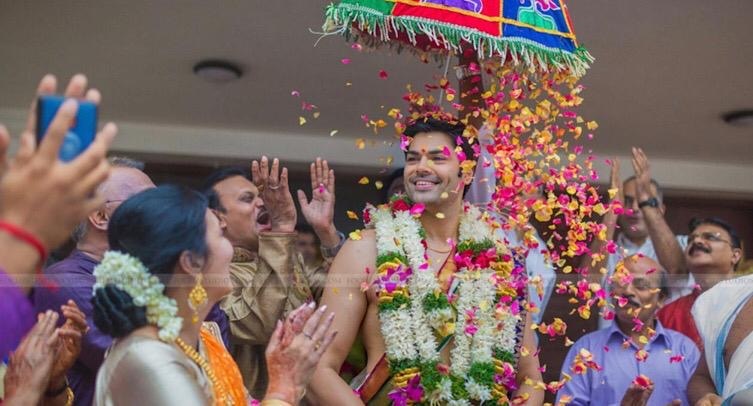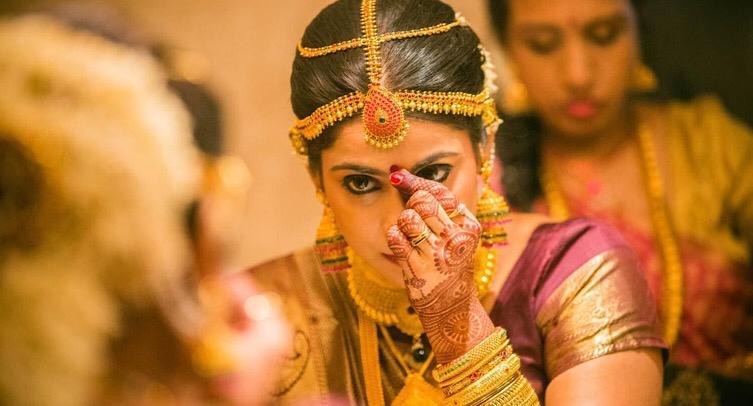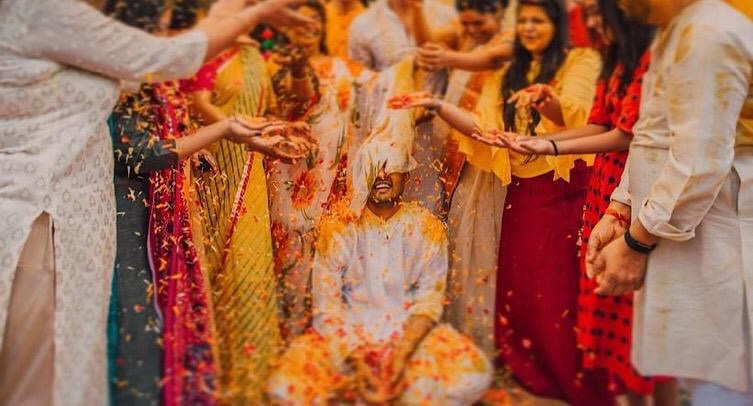Tamil Weddings
Tamil weddings are elaborate and vibrant affairs. The floral riot, rich colours, the sweet sound of nadaswaram and a host of rituals, make them nothing less than a fun-fare. Also, the rituals vary for the Brahmin (Iyer) and Non-Brahmin communities in many ways. So, let us take a look at some common traditional Tamil wedding rituals and customs to help in wedding planning. Tamilians are known for his or her simplicity and elegance albeit it’s something as big and lavish as a marriage .
Pre-Wedding Rituals
Nichayathartham
Nichayathartham refers to the Tamil engagement ceremony. The purpose of this ceremony is to officiate and announce the impending wedding to family and friends. Traditionally, it is organised by the groom’s family during which wedding date, venue etc are decided. In this ceremony, the bride and groom exchange wedding rings.
Panda Kaal Muhurtham
Families of both, the bride as well as the groom, perform this Tamil wedding ritual. It is custom for the families to worship the kula debate to seek blessings. They may either visit a temple or may organize a special puja at home and offer prayers for a smooth marriage process. The bride and groom are not supposed to see each other during this ceremony. Married ladies apply turmeric paste on a bamboo beside the door of the house. The pole is considered to invoke deities so that the prayers offered by the family are granted.
Sumangali Prarthanai
In Sanskrit, Sumangali refers to a married woman whose husband is still alive. Traditionally, the married women wear a nine-yards saree or Madisar for this pooja. During the pooja, the sumangalis are worshipped and treated with an authentic South Indian feast.
Pallikai Thellichal
In this pre-wedding ritual, women from the bride’s family fill earthen pots with nine types of grains along with curd. They nurture and water them till the grains sprout. Pallikai Thellichal symbolises the auspicious beginning of a replacement family. After the wedding, the bride and groom immerse the pot in water to feed the fishes. This custom seeks blessing from nature itself for its abundance and ability to support life in different ways.
Naandi Shrardham
The families of the bride and the groom pray to their ancestors. The family invite Brahmins for a meal and also offer them gifts, sweets, fruits, clothes etc to please them. As a gratitude, the brahmins bless the couple in return.

Wedding Day Rituals
Tamil weddings are held early in the morning and the ceremonies may last for about an hour or so.
Mangal Sanaanam
This ritual takes place at the dawn of the wedding day in both, the bride and groom’s houses respectively. Women smear turmeric paste, kumkum and sesame oil on the bride and the groom as they are considered to cleanse the skin and enhance the beauty before they take bath.
Gauri Pooja
After the bath, the bride does a Gauri Pooja wherein she prays to Goddess Gauri who is considered to protect the virtue of unmarried girls and bless the marital bond. This is the sole ritual which is completed by the bride alone on her day .
Mapillai Varaverpu
The wedding function starts with the arrival of the groom and his attendants of family, relatives and friends. The brides younger brother welcomes the groom. Women from the bride’s family greet the groom with “Aarti”. Lastly, the father of the welcomes the groom with respect and escorts him to the wedding mandap.

Kashi Yatra
Kashi Yatra is, in fact, an interesting and fun custom. The groom pretends to leave for a pilgrimage to Kashi to devote himself to God. He starts to walk away with a walking stick or an umbrella to imply he intends to take the long journey to Kashi. At now , the bride’s brother intervenes and woos the groom back to the wedding hall. In return, the groom’s family gifts the bride’s brother a gold ring.
Pada Puja
Different Tamil communities follow this custom differently. In certain communities, the mother of the bride washes the groom’s pada (feet) with water, sandal paste and kumkum. Among the Mudaliars, the bride and groom wash their parent’s feet respectively at their homes to seek their blessings.
Kanyathanam
The next important step is that the Kanyathanam which accurately means “giving away of the bride”. The bride’s father hands overall responsibility of his daughter to the groom and the groom, in turn, accept her and assures her parents take care of her. In this heartwarming ritual, the bride sits on her father’s lap with a coconut in her hands. The father and bride offer the coconut to the groom while the bride’s mother pours water over the coconut thus symbolizing the ‘Kanyadaan’.

Sapthapathi
Next follows Sapthapathi or the seven steps where the groom takes the bride’s right hand in his left hand and leads her around the sacred fire seven times. Each step has a significance and the priest recites Vedic verses that bond the groom and bride with a promise to share a life together.
Thaali Kattu
This is the foremost important ritual throughout the marriage process. The groom gives the bride the wedding saree. The bride leaves the mandap to wear the Koorai. After the bride returns wearing the Koorai, the bride and groom exchange garland and groom ties the sacred thread around the neck of the bride. At this point, everyone consent to the marriage with showering akshartha (rice, turmeric, flower) on the couple. The joyous occasion is celebrated with a traditional wedding song to the beat of drums and music of nadaswaram. The bride and groom are thereby, pronounced husband and wife.

Ammi Midhithal
The bride has to place her feet on a grinding stone round, It symbolises that the bride wishes that their marital life is as strong and steady as the grinding stone. As soon as she completes this step, her husband puts a metti/ tiny ringlets on her second toe and shows her the Arundhati. In Hindu culture, Arundhati, the wife of sage Vasishta is highly spoken about for her loyalty and devotion to her husband. By asking the bride to look at the Arundhati star, the husband wishes his wife to take up the good virtues of Arundhati.
Paaladaanam
The ritual actually marks the end of the wedding ceremony where the newlyweds seek the blessings of the elders in the family.
Grihapravesham
The most significant of the post-wedding rituals is the entry of the bride at the groom’s house for the first time as his spouse. The groom’s mother welcomes the couple by performing a small aarti.

#ShaadiBag #indianwedding #tamilwedding #indianrituals #tamilrituals #indiatradition #tamiltradition #traditionalwedding #shaadibagevent #weddingday #beautifuldulhan #handsomedulha
Author
Khushi Masarani
Published on : 03-Aug-2020 | By Admin
Recent Reviews
0.00 / 5
Tamil weddings are elaborate and vibrant affairs. The floral riot, rich colours, the sweet sound of nadaswaram and a host of rituals, make them nothing less than a fun-fare. Also, the rituals vary for the Brahmin (Iyer) and Non-Brahmin communities in many ways. So, let us take a look at some common traditional Tamil wedding rituals and customs to help in wedding planning. Tamilians are known for his or her simplicity and elegance albeit it’s something as big and lavish as a marriage .
Pre-Wedding Rituals
Nichayathartham
Nichayathartham refers to the Tamil engagement ceremony. The purpose of this ceremony is to officiate and announce the impending wedding to family and friends. Traditionally, it is organised by the groom’s family during which wedding date, venue etc are decided. In this ceremony, the bride and groom exchange wedding rings.
Panda Kaal Muhurtham
Families of both, the bride as well as the groom, perform this Tamil wedding ritual. It is custom for the families to worship the kula debate to seek blessings. They may either visit a temple or may organize a special puja at home and offer prayers for a smooth marriage process. The bride and groom are not supposed to see each other during this ceremony. Married ladies apply turmeric paste on a bamboo beside the door of the house. The pole is considered to invoke deities so that the prayers offered by the family are granted.
Sumangali Prarthanai
In Sanskrit, Sumangali refers to a married woman whose husband is still alive. Traditionally, the married women wear a nine-yards saree or Madisar for this pooja. During the pooja, the sumangalis are worshipped and treated with an authentic South Indian feast.
Pallikai Thellichal
In this pre-wedding ritual, women from the bride’s family fill earthen pots with nine types of grains along with curd. They nurture and water them till the grains sprout. Pallikai Thellichal symbolises the auspicious beginning of a replacement family. After the wedding, the bride and groom immerse the pot in water to feed the fishes. This custom seeks blessing from nature itself for its abundance and ability to support life in different ways.
Naandi Shrardham
The families of the bride and the groom pray to their ancestors. The family invite Brahmins for a meal and also offer them gifts, sweets, fruits, clothes etc to please them. As a gratitude, the brahmins bless the couple in return.

Wedding Day Rituals
Tamil weddings are held early in the morning and the ceremonies may last for about an hour or so.
Mangal Sanaanam
This ritual takes place at the dawn of the wedding day in both, the bride and groom’s houses respectively. Women smear turmeric paste, kumkum and sesame oil on the bride and the groom as they are considered to cleanse the skin and enhance the beauty before they take bath.
Gauri Pooja
After the bath, the bride does a Gauri Pooja wherein she prays to Goddess Gauri who is considered to protect the virtue of unmarried girls and bless the marital bond. This is the sole ritual which is completed by the bride alone on her day .
Mapillai Varaverpu
The wedding function starts with the arrival of the groom and his attendants of family, relatives and friends. The brides younger brother welcomes the groom. Women from the bride’s family greet the groom with “Aarti”. Lastly, the father of the welcomes the groom with respect and escorts him to the wedding mandap.

Kashi Yatra
Kashi Yatra is, in fact, an interesting and fun custom. The groom pretends to leave for a pilgrimage to Kashi to devote himself to God. He starts to walk away with a walking stick or an umbrella to imply he intends to take the long journey to Kashi. At now , the bride’s brother intervenes and woos the groom back to the wedding hall. In return, the groom’s family gifts the bride’s brother a gold ring.
Pada Puja
Different Tamil communities follow this custom differently. In certain communities, the mother of the bride washes the groom’s pada (feet) with water, sandal paste and kumkum. Among the Mudaliars, the bride and groom wash their parent’s feet respectively at their homes to seek their blessings.
Kanyathanam
The next important step is that the Kanyathanam which accurately means “giving away of the bride”. The bride’s father hands overall responsibility of his daughter to the groom and the groom, in turn, accept her and assures her parents take care of her. In this heartwarming ritual, the bride sits on her father’s lap with a coconut in her hands. The father and bride offer the coconut to the groom while the bride’s mother pours water over the coconut thus symbolizing the ‘Kanyadaan’.

Sapthapathi
Next follows Sapthapathi or the seven steps where the groom takes the bride’s right hand in his left hand and leads her around the sacred fire seven times. Each step has a significance and the priest recites Vedic verses that bond the groom and bride with a promise to share a life together.
Thaali Kattu
This is the foremost important ritual throughout the marriage process. The groom gives the bride the wedding saree. The bride leaves the mandap to wear the Koorai. After the bride returns wearing the Koorai, the bride and groom exchange garland and groom ties the sacred thread around the neck of the bride. At this point, everyone consent to the marriage with showering akshartha (rice, turmeric, flower) on the couple. The joyous occasion is celebrated with a traditional wedding song to the beat of drums and music of nadaswaram. The bride and groom are thereby, pronounced husband and wife.

Ammi Midhithal
The bride has to place her feet on a grinding stone round, It symbolises that the bride wishes that their marital life is as strong and steady as the grinding stone. As soon as she completes this step, her husband puts a metti/ tiny ringlets on her second toe and shows her the Arundhati. In Hindu culture, Arundhati, the wife of sage Vasishta is highly spoken about for her loyalty and devotion to her husband. By asking the bride to look at the Arundhati star, the husband wishes his wife to take up the good virtues of Arundhati.
Paaladaanam
The ritual actually marks the end of the wedding ceremony where the newlyweds seek the blessings of the elders in the family.
Grihapravesham
The most significant of the post-wedding rituals is the entry of the bride at the groom’s house for the first time as his spouse. The groom’s mother welcomes the couple by performing a small aarti.

#ShaadiBag #indianwedding #tamilwedding #indianrituals #tamilrituals #indiatradition #tamiltradition #traditionalwedding #shaadibagevent #weddingday #beautifuldulhan #handsomedulha
Author
Khushi Masarani